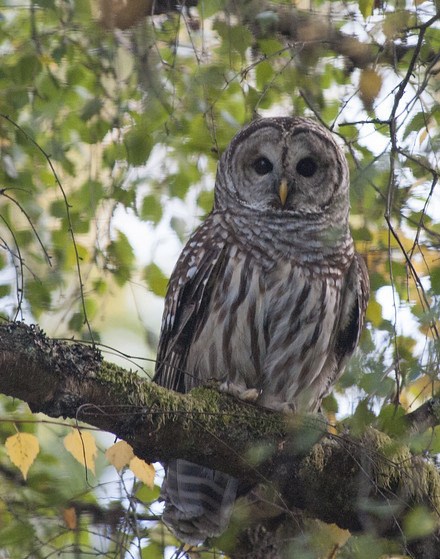If you’ve ever strolled through the Grand Forest, you’ve probably spotted the barred owl signs.
They’re kind of perplexing.
Here you are, on this serene green-gobbled walk, and then a woolly brown flyer interrupts your Walden moment.
“The Grand Forest is habitat to the barred owl,” it reads. “Barred owls can be very aggressive and will attack people. Please use caution.”
Hmm. What exactly does that mean?
At first, the description seems harmless. You grin, imagining an angry Hedwig (although you’re a little off; he’s the wrong breed).
But the more you think about it, the warning, with its countless intangibles, disturbs you.
“On a scale of 1 to 10, how aggressive is ‘very’?” you wonder, as you scan the trees.
“Does this happen all the time?” head swiveling.
The unanswered questions gnaw at you, and you walk a little more briskly.
But, unfortunately, your imagination won’t shut up.
Will they claw out my eyes? Will they get me like the killer rabbit in “Monty Python”? On you panic.
Well, no, not exactly. We asked Brandy Stier, West Sound Wildlife Shelter’s Hospital Manager, to allay our fears. Here’s what she had to say.
How dangerous are barred owls?
Barred owls, like other raptors, have sharp talons and sharp beaks. Their swooping behavior is a protective response; the mated pair is working to remove a predator from the nest area. Swooping at humans appears to involve coming from behind with the intent to strike the head: owls launch from a branch, extending the toes, and impacting with the back or top of the head. The most extensive injuries reported in other areas were shallow scratches that required cleaning but not stitches.
When do these attacks usually occur?
Barred owls may swoop any time of the year if they feel threatened, but they are most likely to swoop from January to April. Nesting and incubation occur from January to April and last between 56 and 70 days. Owls may also become aggressive from the end of March into May if an owlet is on the ground due to nest destruction or is a fledgling. Fledgling owlets are learning to fly and will spend around a week on the ground while developing flight muscles and figuring out the mechanics of landing.
What precautions should you take?
Avoid activities near a nest site, especially during January, February, and March, and decrease activities in the early morning. West Sound Wildlife received a number of phone calls reporting swooping behavior in the Grand Forest, especially in February, and most attacks were targeted at joggers between 6 and 8 a.m.
If you are out birding during the nesting season, avoid playing bird calls. Barred owls are known to respond very aggressively to great horned owl calls as the great horned owls will prey upon eggs, owlets and adults.
Calls from songbirds and other smaller species, including other owls and woodpeckers, may attract the attention of an owl looking for an easy meal; barred owls are opportunistic eaters and raising owlets requires a lot of energy.
How can you protect yourself?
Protect your head and face by pulling a jacket up over your neck and head. Wave your arms over your head to appear larger and to make targeting more difficult.
Also highly recommended: either backing out of the area you have entered or moving quickly through it. The owl will continue to swoop until you have moved away from the nest site.
Say goodbye to your beanies!
Most callers mentioned dodging an owl that came at them from behind, while on a jog or run, and said that the owls were stealing beanies, especially those with pom-poms.


